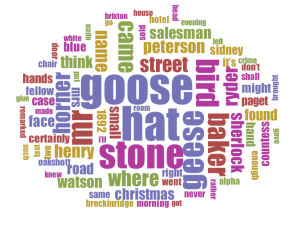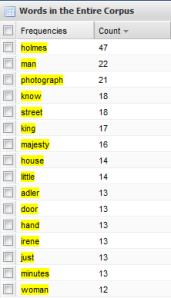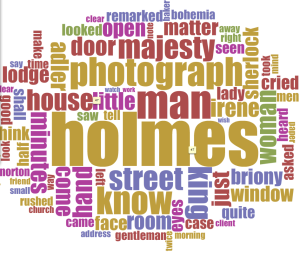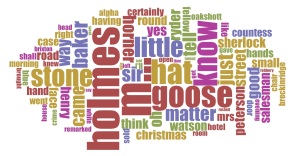I created a word cloud of Arthur Conan Doyle’s The Blue Carbuncle using Voyant Tools. The site is easy to use and navigate, however I do wish that Voyant offered the option to change the colors, font, and orientation of the text as Wordle does.
In order to get an accurate depiction of The Blue Carbuncle, I removed stop words including mostly prepositions and conjunctions. Even after this, though, Holmes was still the most prominent word in the cloud, appearing a total of 39 times. While Holmes is the detective, I still felt that his name consumed so much space in the word cloud that it was difficult to actually grasp any of the main points of The Blue Carbuncle. I added his name to the list of stop words and then the word Hat then became most salient in the cloud, appearing 30 times! This was not shocking, considering that the hat helps Sherlock determine who ended up with the goose. Not surprisingly, the words goose, and bird both appear over 20 times, while stone appears 21 times. All of these words appear frequently because in the story, Holmes spends plenty of time trying to figure out how the stone ended up inside the goose.
What I liked most about my word cloud is that the characters’ names were quite visible. After I added all of the prepositions and conjunctions to the list of stop words, the names Baker (appears 18 times), and Peterson (11 times) became more outstanding. This is important because it reminds us of Mr. Baker purchasing the goose with the stone, and Mr. Peterson, who presented the case of the blue carbuncle to Holmes.
Overall, Voyant Tools made it simple to create a word cloud, but not one that is unique or visually appealing. As discussed in the Nieman Lab article we read this week, I do not think that Word Clouds have much purpose, unless you are trying only to observe word usage in a text. My word cloud displays the main characters and ideas of The Blue Carbuncle but you can’t make sense of what actually went on in the story unless you read it.



